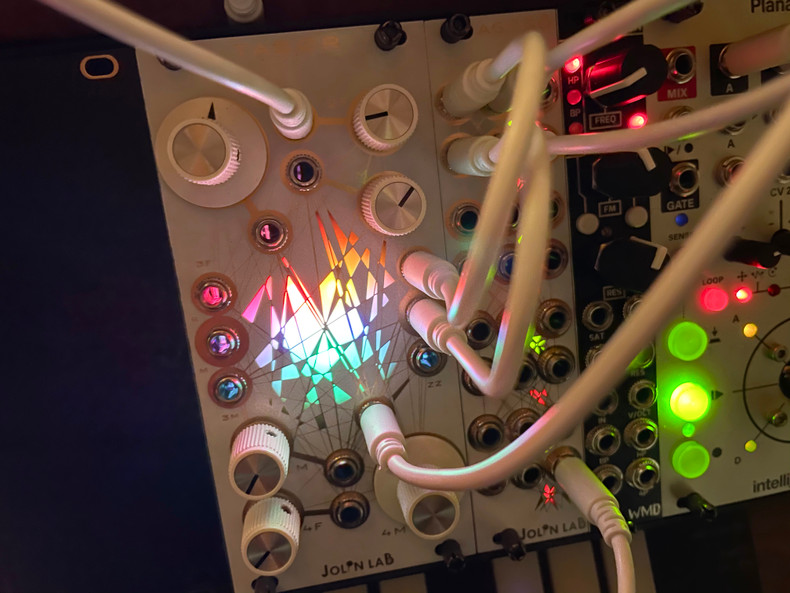We are very honored to be the first US/JAPAN dealer for these beautiful modules designed by Jolin Lab from Milan ITALY!!!
http://www.boutiquepedalnyc.us/jolin-lab/

You are gonna love these!!!
Both modules are available in 3 different faceplates - Black Orb/Black Mirror/White Mirror...
https://www.boutiquepedalnyc.us/jolin-lab-tabor-bl...

TABØR is a rhythmic analogue sound and CV source based on the unpredictability of four avalanche transistors in a continuous oscillation state.
These unpredictable core oscillators are related to each other and their charge and discharge cycle creates complex rhythmic sound textures that can be controlled and triggered with external CV inputs to add more contamination.
With this circuit we can obtain rhythmic textures- intended as rise pulses – and different tone heights by mixing the colors of the LEDs and the values of the capacitors. The waveform of a single oscillator, unfiltered, is basically a sawtooth. The result of the FM modulation of the whole sound engine is chaotic.
Features
Four avalanche oscillators with two controls each:
F: regulates the distance between the spikes of the single sawtooth waves - their rise pulses frequency
M: the amount of cross-modulation of each core within the others
Each oscillator can be identified thanks to its color and it can acts differently depending on the state of the others:
OSC1: the most percussive and predominant, the fundamental modulator
OSC2: obedient to OSC1 rhythmically and its direct subsidiary - a carrier
OSC3: strictly related to OSC2 but can set-aside OSC1 as a modulator
Due to its autonomy from the fundamental OSC1 and to keep the communication balanced, OSC3 doesn't have the F and M control potentiometers. Its values can be changed only with external CV input
OSC4: it can act as a shutter to filter or interrupt the whole communication
these variables can all be controlled individually with vactrol CV inputs
Visually you can see the "beating" oscillators in the hollow circle in the middle of the module.
To start oscillate and communicate the sound engine needs around 16v to 22v and any value below that point will stop hierarchically its operation:
RM: this input act as an attenuator to the oscillators, limiting their power supply
A dummy cable will shut down the oscillators due to the inverted-vactrol configuration of this input. The RM input can be used as an internal voltage-controlled-attenuator, a VCA
The result of the whole sound engine is given in three different outputs:
TR: a “squarified” always positive 0-7v trigger / cv source
This output is not always active, it fires triggers when the avalanche engine reaches a certain threshold: blue LEDs blinking
NM: the dry mixed audio signal straight out of the oscillators
ZZ: an auxiliary fuzzed envelope output from the internal diode-based distortion circuit
- 12 HP
- 29 mm deep (Through-hole Full Kit 45mm)
- 65 mA +12V
- 7 mA -12V
- 0 mA 5V
https://www.boutiquepedalnyc.us/jolin-lab-agogo-bl...

Stream of Gates.
AGOGÔ is an octal analogue vactrol-based low pass gate and mixer in a cascade
configuration.
Each one of its inputs, CVs and outputs are normalized and buffered to the next one: it can be used as a multiplier and a mixer for both audio and CV.
One way to imagine AGOGÔ is to use water and streams.
In the module we have three rivers:
“I” – inputs
“V” – CVs and modulations and
“O” – outputs
“I” is flowing from top to bottom. An input inserted in the first socket will be buffered and it will flow unaltered in the next. If a cable is inserted, the connection will be interrupted.
“V” works in the same way but there is some latency in the interruption due to its chained vactrol configuration. This means that with a single control voltage you can open all the gates simultaneously.
Combining the features of both “I” and “V” you can – for example – control a single signal with 8 different CVs or 8 different sources with the same CV. The streams can be interrupted in any point, this means that all the LPGs can be used individually or in pair for stereo effects or send/return divisions.
The last stream, “O” represents the end of the flow, the river mouth. It acts as an active mixer, letting you mix 8 or more signals. As in the other streams, the connection can be interrupted in any given point to create sub mixes or individual outs.
More units can be chained together thanks to headers on the back. This chained configuration will add saturation to the final out.
- 180 mA +12V
- 100 mA -12V
- 0 mA 5V
- 28 mm deep
grazie mille to Federico @Jolin Lab!!!
for beautiful packaging, products & beyond!!!



#eurorack #modularsynths #jolinlab #tabor #avalanche #drone #rhythmic #oscillator #agogo #chained #vactrol #LPG #Mixer #US #Japan #authorized #dealer #buy #ユーロラック #モジュラーシンセ #販売 #購入 #madeinitaly

